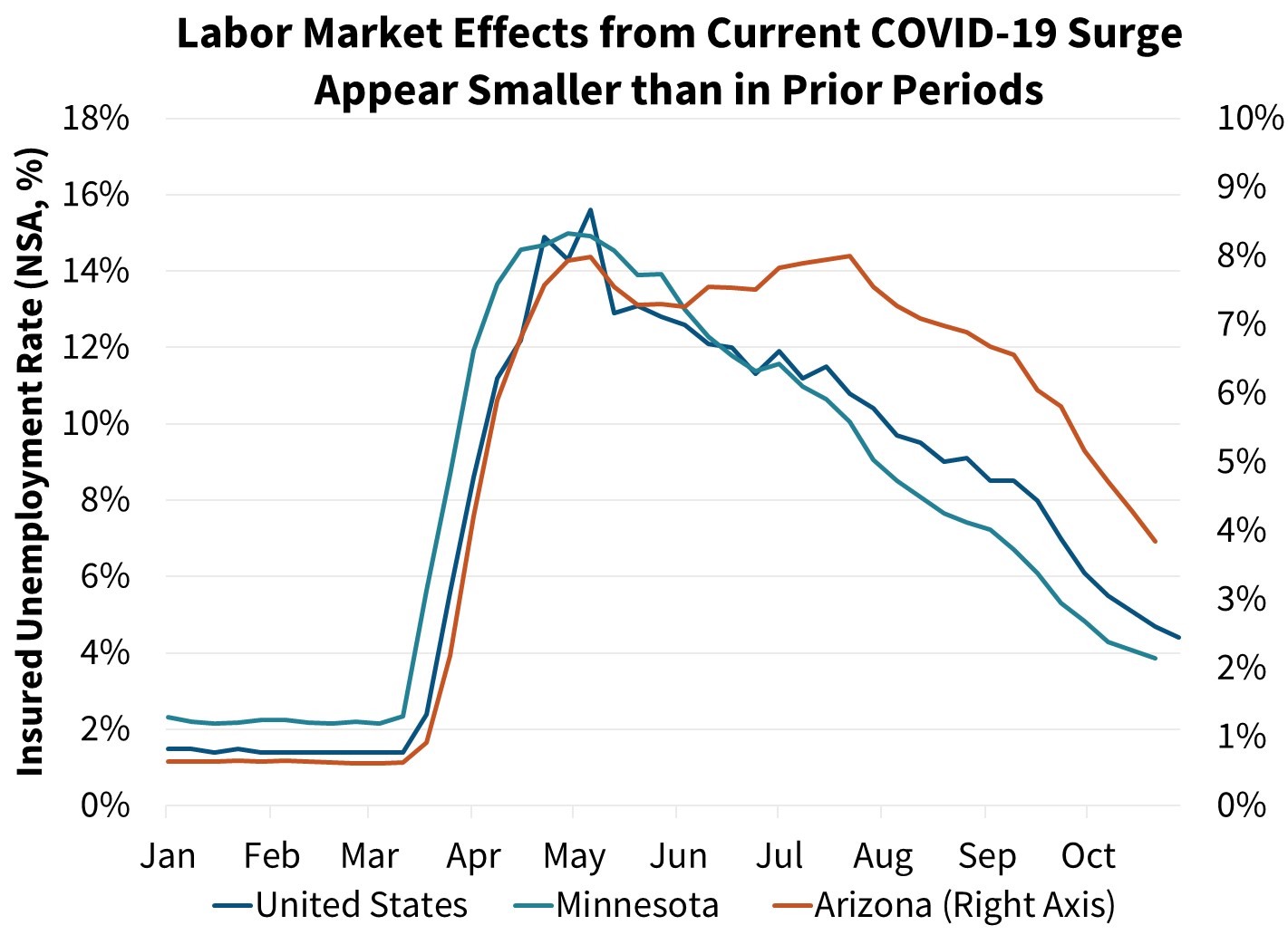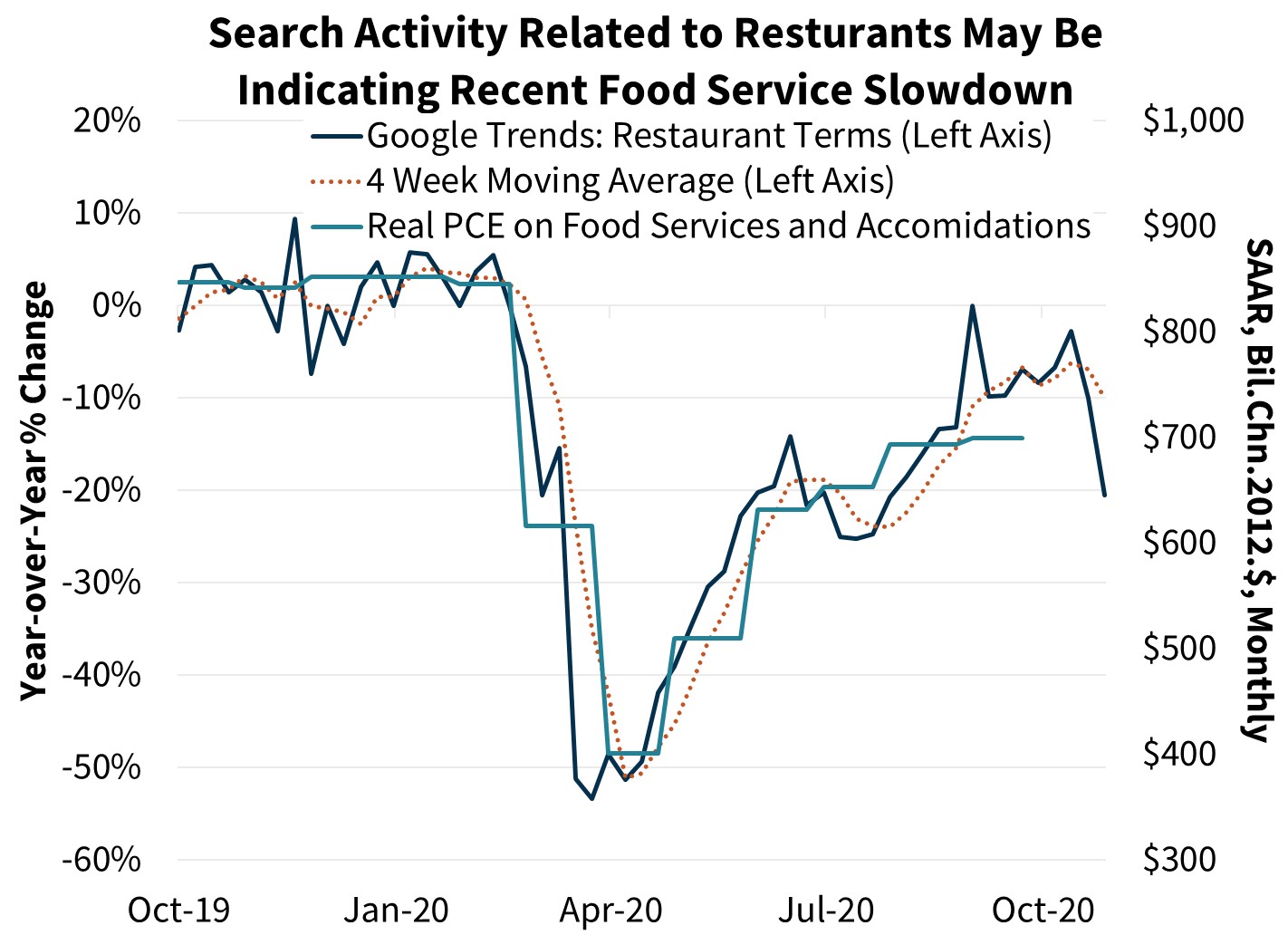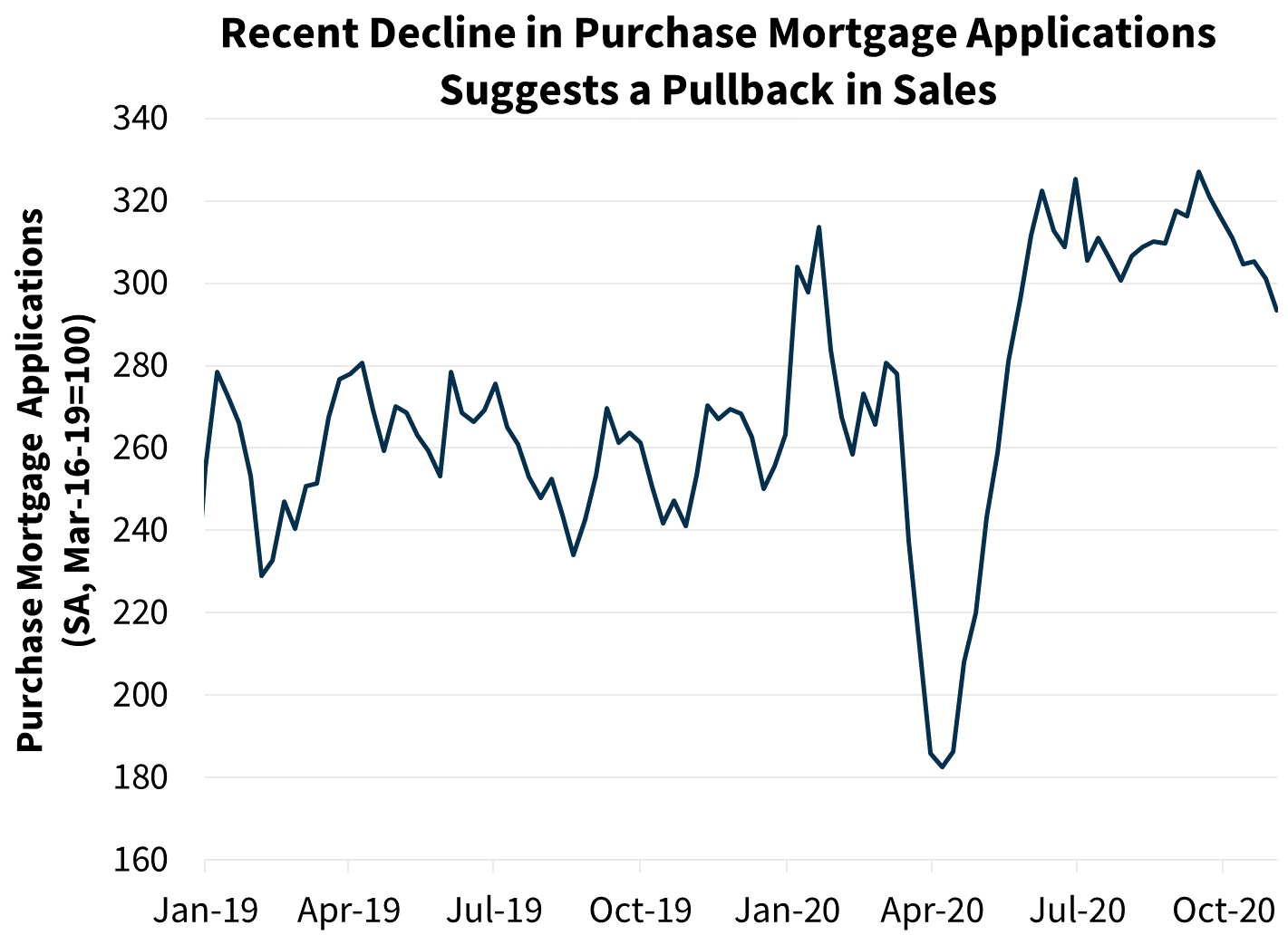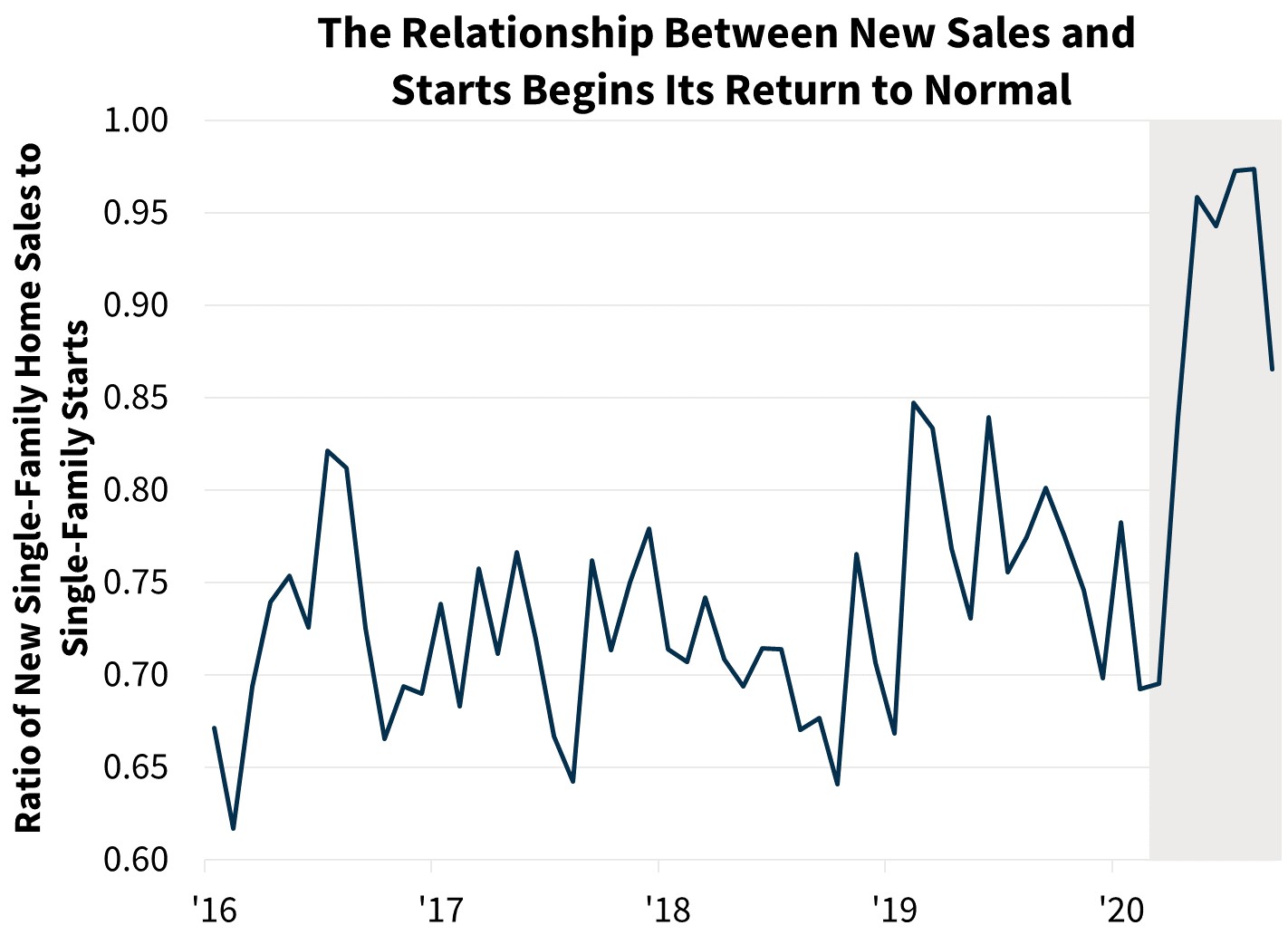Continued Growth Contingent on COVID-19 Resurgence
We increased our full-year 2020 growth forecast by one-tenth to a still-negative 2.5 percent. Q3 real gross domestic product (GDP) growth came in somewhat above expectations (33.1 percent versus 31.6 percent annualized). However, we downgraded our forecast for Q4 2020 and the first half of next year in light of resurging COVID-19 cases. We now forecast growth in 2021 to be 3.3 percent, down two-tenths from last month’s forecast. Looking ahead to 2022, we expect GDP to rise 3.0 percent. We continue to believe that the ingredients for further recovery in the near-term are present, even in the absence of an additional stimulus bill. An elevated savings rate, rising asset prices, and an improving labor market should provide ample fuel for consumers to drive continued growth. However, we believe the response of consumers and policy makers to COVID-19 cases and hospitalizations hitting new highs both here in the U.S. and abroad will likely determine whether further improvement is realized, and this uncertainty represents heightened risk to the forecast.
Meanwhile, in line with our prior month’s projection, residential fixed investment (RFI) posted a sharp rebound in Q3 of 59.3 percent annualized and, based on recent construction trends, is poised for continued growth in Q4 as well. We forecast RFI will grow 18.1 percent annualized for the fourth quarter before moderating in early 2021. Home sales continued to exceed our expectations in September, leading to an upgrade of our existing homes sales forecast over the next couple quarters, alongside more modest revisions to housing starts and new home sales. However, signs of a slowdown are finally appearing, and the resurgence in COVID-19 cases could dampen sales going forward due to infection avoidance behavior. Additionally, the pent-up demand from the spring may finally be receding, and tight inventories will likely continue to restrain sales. Still, we expect total home sales in 2020 to be 5.7 percent higher than in 2019, followed by more modest growth of 0.8 percent in 2021, and 0.3 percent in 2022. Consistent with this housing outlook, we modestly increased our forecast for mortgage originations in 2020 by $34 billion to $4.1 trillion and in 2021 by $99 billion to $2.7 trillion. Originations in 2022 are forecast to total $2.5 trillion.
COVID-19 Is in the Driver’s Seat
If not for the rise in COVID-19 cases, growth expectations would be greater. In part due to unprecedented levels of fiscal policy support, real personal disposable income was 3.9 percent higher in September compared to pre-COVID levels, and rising home and equity values have helped boost household balance sheets. At 14.3 percent, the personal savings rate remained elevated in September, providing potential consumer spending power. In addition, the labor market recovery, while slowing relative to the early summer months, continued at what normally would be considered a brisk pace in October, adding 638,000 jobs to payroll employment.

However, with the onset of cooler weather and COVID-19’s resurgence, the future path of the pandemic and the country’s reaction remain uncertain. As of this writing, fatality rates remain well below the prior peak, but measured cases and total hospitalizations are higher than both the initial outbreak in the spring and the Sunbelt flare up over the summer. Much of this can be explained by a surge in cases in colder states in the upper Midwest, Great Plains, and Mountain West regions, which had previously been comparatively unaffected by COVID-19. In that sense, the current pattern can be thought of as the last regions of the country experiencing their “first wave.” However, cases are rising in all states, including in New York, the epicenter of the spring outbreak.
To date, regional measures of economic activity do not appear to be responding as negatively to the resurgence as they had previously. During the Sunbelt flare up over the summer, evidence of the labor market recovery stalling relative to the national trend was present, as seen most visibly by Arizona’s continuing unemployment claims data. While this data is often noisy, other Sunbelt states exhibited similar patterns over the period and various high frequency measures such as credit card usage and mobility data suggested a pause in their economic recoveries. More recently, cases have surged in many northern states, and, as yet, there is no obvious disruption to unemployment metrics on either a national or state level. This could be due to a greater COVID-19 adaptability on the part of firms and households and growing “distancing fatigue.”

However, there are some emerging signals of a behavioral shift toward greater social distancing. Search term data from Google Trends related to restaurants and dining, one of the most at-risk sectors, showed a pullback over the past couple of weeks. While the relationship is not perfect, Google search activity has been correlated with consumer spending on food establishments over the past year. Data from OpenTable, a restaurant reservation app, also indicated a recent correlation between states with the largest increases in cases and slowdowns in reservation activity.
Therefore, we believe that consumer and firm behaviors will likely be affected by increasing COVID cases but by a lesser magnitude for any given level of outbreak compared to prior periods. Our baseline forecast assumes that the recovery in growth will slow but not contract again. We revised down our expectation of personal consumption expenditures (PCE) for the remainder of the year and early 2021. The PCE growth forecast of 4.2 percent annualized in Q4 is somewhat misleading as it is entirely due to base effects. Growth in consumption over Q3 left PCE in September at a significantly higher level than the average of the third quarter. Even if consumption in Q4 remains flat at the current September level, it would translate to a 4.3 percent annualized quarterly growth rate. Therefore, our forecast is consistent with flat-to-slight declines in consumption spending on net over the coming months. Slowing credit and debit card activity as well as a modest pullback in auto sales in October are supportive of this view.
There remains a high level of uncertainty around our consumption forecast. As hospitalization rates rise, a return to lockdowns and other strict distancing measures may occur in some regions, which would almost certainly harm growth. As of this writing a handful of states have already implemented modest restriction measures. In many European countries, however, where cases began to rise about a month earlier than in the U.S., more substantial lockdowns have been reinstated in recent weeks. If a similar outcome occurs here, we believe it would be far less detrimental to output than the spring lockdowns. This is in part due to the economy being better positioned to operate in an environment of social distancing, but also because the hardest hit sectors have not yet fully recovered, so a smaller share of economic output would be lost. However, closing wide swaths of activity, including food service and other sectors that were more affected by earlier lockdowns, could still lead to a second, short-term contraction in GDP. Alternatively, if more severe lockdown measures are avoided or not enforced and vaccine development news continues to be positive, then consumer spending may be more resilient and growth could easily exceed our baseline forecast. The coming weeks will be pivotal to the outlook.
Election Results Reduce Policy Uncertainty but Also Prospect for Stimulus
While votes are still being counted and two remaining Senate seats will be determined by runoff elections in early January, it appears likely that the next President and Senate majority will be opposing parties combined with the narrowest House majority in decades. This result means a greatly diminished level of policy uncertainty going forward, as sweeping legislation would require bipartisan support. Thus, a large additional stimulus bill is now less likely, removing a meaningful short-term upside risk to growth. Our forecast assumes no additional legislation, except for the continuation of broadened unemployment benefits set to expire on January 1. The failure to renew these benefits represents a downside risk. Policy changes regarding trade, healthcare, taxes, energy, and other areas, however, are now likely to be modest, removing several upside and downside risks to economic growth in the coming years, as well as general uncertainty.
Turning to monetary policy, at the Federal Open Market Committee’s (FOMC) November meeting the federal funds rate was left unchanged at the zero-lower bound, as was universally expected. FOMC Chairman Jerome Powell reiterated that accommodative monetary policy would remain for the foreseeable future until inflation is running above 2 percent for some time and the economy and labor market fully recover from the COVID-19 crisis. At the press conference, Powell again emphasized the importance of fiscal policy, in tandem with the Fed’s monetary policy, to an economic recovery. With statements like, “[The Fed has] lending powers, not spending powers,” Powell put the onus of producing direct support to consumers back on Congress. Given the diminished likelihood of additional large fiscal policy support in the near term, continued accommodative monetary policy becomes more likely for a longer time horizon.
How consumer sentiment responds to the election results is a near-term risk. Typically, there is a modest temporary boost to confidence in the months following the election of a new President, when the winning side’s partisans have a stronger positive response than the losing side’s negative reaction, but then sentiment returns to a more normalized level. However, in 2016, consumer sentiment surveys jumped by an unexpectedly large amount and maintained the gains until the COVID-19 crisis. This phenomenon is not well understood, so there remains greater uncertainty regarding the path of consumer confidence in the coming months, adding additional uncertainty to the outlook.
Home Sales Surprise to the Upside, Though Pullback Likely Underway
Existing home sales surprised to the upside in September, rising 9.4 percent to an annualized pace of 6.54 million units. This was the fastest pace of sales since May 2006. Sales year-to-date are now recovered from the COVID-19-related declines, coming in essentially flat compared to the same period in 2019. In retrospect, we were too quick to call for a pullback in sales, but we continue to believe the current pace to be unsustainable. The months’ supply of inventory for sale at the current sales pace fell to 2.7 in September, the lowest on record. While listings data showed a year-over-year gain in October, new listings year-to-date in 2020 remained over 5 percent below 2019 levels. According to the National Association of Realtors, total inventories for existing homes were down 19.2 percent in September from a year prior, compared to a rise in sales of 20.9 percent. This disconnect is driving home prices higher, offsetting much of the affordability gains from lower mortgage rates. According to the FHFA Purchase-Only Index, home prices were up 8.1 percent in August from a year prior, the fastest annual growth rate since 2006 and an acceleration from around 5.0 percent three months earlier. The continued rise in home prices is being noticed by consumers, as the share of respondents in the Fannie Mae Home Purchase Sentiment Index (HPSI) indicating that it is a bad time to buy a home due to high home prices increased significantly in October. While high prices may entice more homeowners to list, alleviating some inventory scarcity, at some point affordability constraints will dampen sales. This is especially true as mortgage rates are unlikely to fall much further.

Short-term indicators suggest continued sales strength in the near term; however, the first signs of a pullback are appearing. Pending sales, which lead closings on average by 30-45 days, fell modestly by 2.2 percent in September. Furthermore, purchase mortgage applications, while still elevated, have trended downward in recent weeks. We revised upward our Q4 and Q1 2021 existing home sales forecast based on incoming data but expect month-over-month sales to trend downward from September’s pace in the coming months.
For some time, we have expected an eventual divergence in the growth rates of starts versus new single-family home sales. The latter greatly exceeded its usual relationship with starts since the spring, representing a drawdown of completed home inventories and homebuilders generating sales of homes not yet started. Homebuilders therefore needed to increase the pace of construction relative to sales to bring this relationship back to a sustainable alignment. In September, we believe that process began, as new home sales pulled back 3.5 percent, while single-family starts increased 8.5 percent to 1.1 million annualized units, the fastest pace since 2007. On Q3 earnings calls, publicly traded homebuilders noted that while COVID-19 warrants caution, they are generally bullish on buyer demand going forward, consistent with homebuilder sentiment hitting new historical highs in October. However, multiple firms also stated that construction programs need to be stronger to rebuild inventories. While low mortgage rates, a low supply of existing homes for sale, and heightened interest in suburban areas will continue to support new home sales moving into next year, we expect the ratio of new home sales to single-family housing starts to normalize in the coming quarters as starts continue to expand and sales comparatively lag.

Regarding multifamily housing construction, starts fell for the second consecutive month in September, declining 16.3 percent to 307,000 annualized units. This series is notoriously volatile, but we believe the underlying trend in multifamily construction will be weak for the foreseeable future relative to single-family construction. While suburban multifamily demand is expected to hold up better, we believe the shift of at least some renters out of large metro areas and into homeownership combined with continued remote working arrangements will weaken demand for new projects in many areas relative to the expectations at the time the projects were first conceived.
For more on multifamily market conditions please see the November 2020 Multifamily Market Commentary.
Mortgage Originations Revised Modestly Upwards
We made small upward revisions to our forecast of purchase mortgage originations this month, corresponding to the upgraded housing forecast as well as recent strength in incoming acquisition and securitization data. Purchase mortgage volumes are expected to total $1.5 trillion in 2020, about $34 billion higher than last month’s forecast. In 2021, we expect purchase mortgage volumes to grow by a further 4.2 percent to just under $1.6 trillion. Next year’s growth would represent a deceleration from this year, as slowing home sales and home price growth in 2021 dampens volumes.
We continue to expect 2020 refinance volumes of $2.6 trillion, unchanged from last month’s forecast. This view is supported by strong acquisition and agency securitization volumes. The total expected origination volume of $4.1 trillion for 2020 would be the highest on record, surpassing an estimated $3.7 trillion in 2003. For 2021, we upgraded our refinance forecast by $69 billion from last month, to a total of $1.1 trillion. Refinance application activity should remain strong headed into next year, supported by a continued low rate environment. In fact, at the current interest rate of 2.78 percent — an all-time low — we estimate that 65 percent of outstanding first-lien loan balances have at least a one-half-percentage point incentive to refinance.
We expect current mortgage rates to be close to troughing, however. No further declines are forecast in the coming months, especially with the 10-year Treasury yield on the rise. After the election, the 10-year yield grew steadily, increasing nearly 20 basis points in under a week to its current level of 0.96 percent. The primary spread (30-year mortgage rate minus the 10-year Treasury yield) fell below 200 basis points at the end of October for the first time in eight months, and we expect further spread compression as mortgage rates stay steady and the 10-year continues to rise.
Economic & Strategic Research (ESR) Group
November 11, 2020
For a snapshot of macroeconomic and housing data between the monthly forecasts, please read ESR’s Economic and Housing Weekly Notes.
Data sources for charts: Department of Labor, Mortgage Bankers Association, Census Bureau, Google Trends, Bureau of Economic Analysis, Fannie Mae ESR Group.
Opinions, analyses, estimates, forecasts and other views of Fannie Mae's Economic & Strategic Research (ESR) Group included in these materials should not be construed as indicating Fannie Mae's business prospects or expected results, are based on a number of assumptions, and are subject to change without notice. How this information affects Fannie Mae will depend on many factors. Although the ESR group bases its opinions, analyses, estimates, forecasts and other views on information it considers reliable, it does not guarantee that the information provided in these materials is accurate, current or suitable for any particular purpose. Changes in the assumptions or the information underlying these views could produce materially different results. The analyses, opinions, estimates, forecasts and other views published by the ESR group represent the views of that group as of the date indicated and do not necessarily represent the views of Fannie Mae or its management.
ESR Macroeconomic Forecast Team
- Doug Duncan, SVP and Chief Economist
- Mark Palim, VP and Deputy Chief Economist
- Eric Brescia, Economist
- Nick Embrey, Economist
- Rebecca Meeker, Financial Economist
- Richard Goyette, Business Analyst
